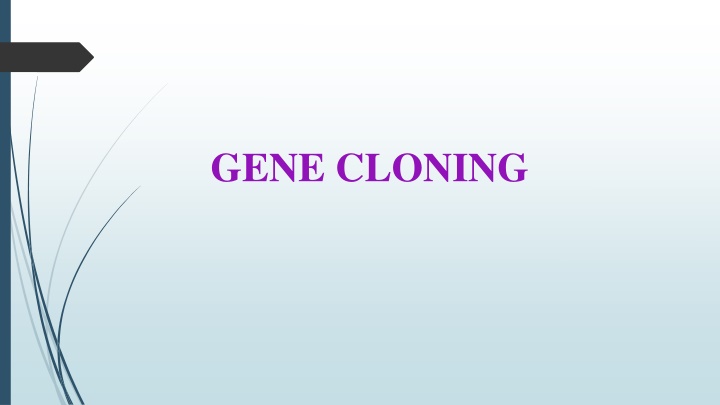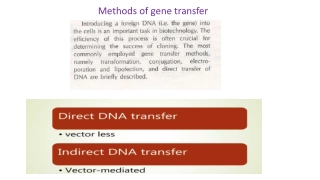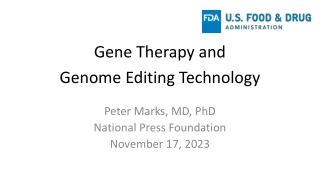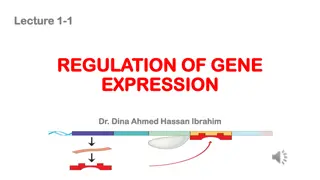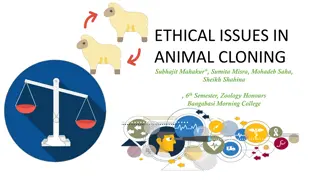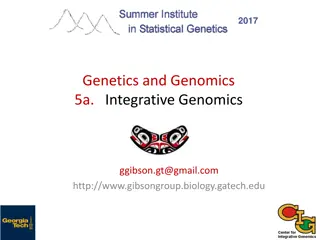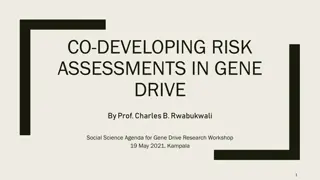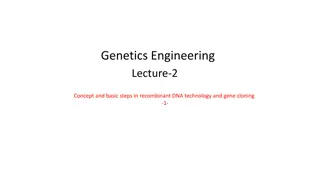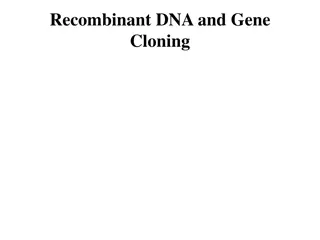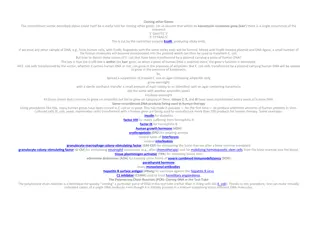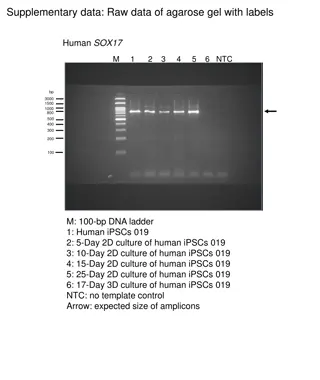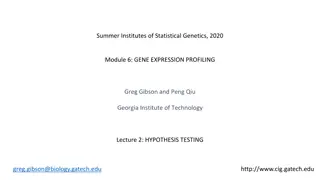GENE CLONING
Gene cloning, also known as DNA cloning, involves making identical copies of a specific gene or DNA segment for research and biotechnological applications. The process includes isolating DNA, cutting it with restriction enzymes, selecting a vector, ligating DNA fragments, transforming the plasmid into a host organism, selecting transformed cells, and replicating the gene of interest.
Download Presentation

Please find below an Image/Link to download the presentation.
The content on the website is provided AS IS for your information and personal use only. It may not be sold, licensed, or shared on other websites without obtaining consent from the author.If you encounter any issues during the download, it is possible that the publisher has removed the file from their server.
You are allowed to download the files provided on this website for personal or commercial use, subject to the condition that they are used lawfully. All files are the property of their respective owners.
The content on the website is provided AS IS for your information and personal use only. It may not be sold, licensed, or shared on other websites without obtaining consent from the author.
E N D
Presentation Transcript
CONTENTS Introduction Process of gene cloning Successful gene cloning experiments Future of gene cloning Application of gene cloning
INTRODUCTION Gene cloning, also known as DNA cloning, is the process of making identical copies of a specific gene or a segment of DNA. This involves the isolation and replication of a DNA fragment, which can be a single gene or a piece of genetic material with specific functions in order to study it or use it for various applications. Gene cloning is a fundamental technique in genetic research, biotechnology, genetic engineering allowing scientists to explore gene functions, produce re-combinant organisms for a beneficial purposes. proteins, and modify
PROCESS OF GENE CLONING 1) ISOLATION OF DNA The first step is to isolate the DNA containing the gene of interest. This DNA can be obtained from a variety of sources, such as the genome of an organism or a specific DNA segment. 2) DIGESTION WITH RESTRICTION ENZYMES DNA is then cut at specific sequences using enzymes called restriction enzymes. These enzymes recognize and cleave DNA at particular sites.
CONT 3) PLASMID OR VECTOR SELECTION A small, circular DNA molecule, typically a plasmid or another vector is chosen to carry the gene of interest. This vector will be used to insert and replicate the gene. 4) LIGATION DNA ligase, an enzyme is used to join the cut DNA fragments together. This process results in the gene of interest being inserted into the plasmid and creating a recombinant DNA molecule.
CONT 5) TRANSFORMATION The recombinant plasmid is introduced into a host organism, often bacteria. This is achieved by process of heat shock which decrease the permeability of membrane and the host organism will replicate the plasmid along with its inserted gene.
CONT 6) SELECTION Selective markers, such as antibiotic resistance genes are commonly included in the plasmid. Host organism containing the recombinant plasmid can be identified and selected by growing them in a medium containing the corresponding antibiotic.
CONT 7) REPLICATION AND CLONING As the host organism multiplies, it replicates the recombinant plasmid. This results in the cloning of the gene of interest, with multiple identical copies being produced.
CONT 8) HARVESTING AND VERIFICATION Once a sufficient number of cloned gene copies have been produced, they can be harvested. The cloned gene s identity and sequence can be verified through techniques like DNA sequencing. The cloned gene can then be used for various purposes.
SUCCESSFUL GENE CLONING EXPERIMENTS Cloning the Insulin Gene (1978): This was one of the early successes in gene cloning. Scientists cloned the human insulin gene into bacteria, allowing for the mass production of human insulin, which revolutionized the treatment of diabetes. Cloning the Green Fluorescent Protein (GFP) Gene (1994): Roger Y. Tsien and Martin Chalfie, among others, cloned the GFP gene from a jellyfish, leading to its widespread use as a molecular marker in cell and molecular biology. GFP can be used to tag and visualize proteins and other cellular components. Cloning the Human Genome (2003): The Human Genome Project successfully cloned and sequenced the entire human genome, providing a comprehensive map of human genes and their functions.
CONT Cloning of Antibody Genes (1980s-1990s): Scientists have cloned genes encoding antibodies to produce monoclonal antibodies. This technique has been invaluable in research, diagnostics, and the development of therapeutic antibodies. Recombinant DNA Technology (1973): The foundational experiment by Herbert Boyer and Stanley Cohen marked the beginning of gene cloning. They successfully cloned the first recombinant DNA molecule, which contained genes from two different organisms (E. coli and a plasmid).
FUTURE OF GENE CLONING Advanced Genome Editing Technologies Customized Therapies Gene Therapy Vaccine Development Agriculture and Biotechnology Functional Genomics
APPLICATION OF GENE CLONING Production of Recombinant Proteins Gene Therapy Vaccine Development Functional Genomics Genetic Modification Creation of Transgenic Animals Pharmaceutical Production Research in Molecular Biology Environmental Applications Forensic Science Drug Discovery
